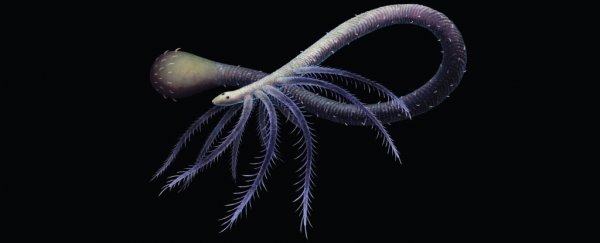Once upon a time, a small worm mucking about on the Cambrian seafloor did something really, really careless: it lost its legs.
As the old saying goes, "use it or lose it". Since the worm - a squirmy creature belonging to the Facivermis genus - was not using its legs for locomotion, it evolved into a more primitive, legless animal.
It's not just a brilliant example of an animal evolving from a more complex creature to a more streamlined one. At 518 million years old, this case of 'backwards' evolution, so to speak, is the earliest known example of this occurring.
"We generally view organisms evolving from simple to more complex body plans, but occasionally we see the opposite occurring," said palaeobiologist Xiaoya Ma of the University of Exeter in the UK.
"What excited us in this study is that even at this early stage of animal evolution, secondary-loss modifications - and in this case, reverting 'back' to lose some of its legs - had already occurred."
 (Howard et al., Current Biology, 2020)
(Howard et al., Current Biology, 2020)
Multicellular life is thought to have emerged during the Ediacaran Period, which started 635 million years ago. But it wasn't until the Cambrian, which started around 541 million years ago, that life really started to diversify.
In an event called the Cambrian explosion, most of the major animal phyla appeared on the fossil record over a period of about 25 million years in marine ecosystems around the world. These would eventually diversify further, and evolve to produce pretty much all multicellular life surviving today.
Back then, those Cambrian critters were some real oddballs, evolving some of the features that we find really useful today - eyes, spines, heads, bilateral symmetry, and, of course, legs. But not every creature that evolves a trait necessarily needs it forever.
Think of snakes, which had legs, and eventually lost them again, because they developed a different, perfectly functional style of locomotion.
Or stick insects, which seem to have evolved and lost wings several times over the course of their history. This loss of an evolved feature to revert to a previous state is called secondary loss or reversion.
But the Facivermis genus - creatures we've known about for several decades - have been something of a mystery. The worm has a long body with a bulbous bottom, hooks around the anus, and five pairs of feathery appendages up the top near its head.
Some studies thought the worm might be the missing link between legless marine worms of the Cycloneuralia clade, and ancient extinct creatures called lobopodians - a group of worms that includes the famous Burgess Shale beastie Hallucigenia, and typically have pairs of legs along the length of their bodies.
But exquisite new fossils from China have revealed more information about the strange critter. In particular, a fossil with a tube around the lower portion of the animal, indicating that Facivermis was anchored, and lived a lot like modern tubeworms do.
"Living like this, its lower limbs would not have been useful, and over time the species ceased to have them," said palaeobiologist Richard Howard of the University of Exeter.
"Most of its relatives had three to nine sets of lower legs for walking, but our findings suggest Facivermis remained in place and used its upper limbs to filter food from the water."
 (Franz Anthony)
(Franz Anthony)
The team's phylogenetic analyses concluded that Facivermis was not related to cycloneuralians - it's pure lobopodian. Other lobopodians have two distinct kinds of legs - longer ones used for grasping at the front of the body, and shorter clawed ones at the back for crawling. Facivermis lost the back set, keeping the front ones for filter feeding.
Lobopodians eventually evolved into arthropods (insects, crabs, shrimps and spiders), tardigrades and onychophorans (velvet worms). The team's analysis found that Facivermis was likely derived from the onychophoran stem group, rather than the basal group from which all three emerged.
"We therefore conclude," they wrote in their paper, "that Facivermis provides a rare early Cambrian example of secondary loss to accommodate a highly specialised tube-dwelling lifestyle."
The research has been published in Current Biology.
